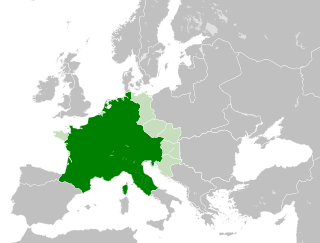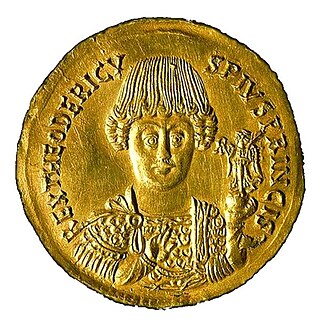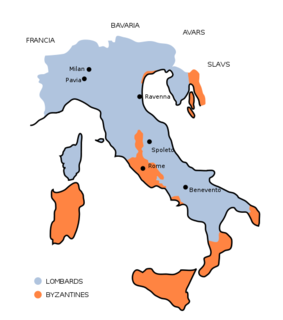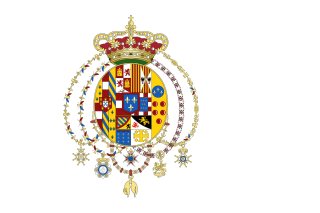
The Holy Roman Empire was a multi-ethnic complex of territories in Western and Central Europe that developed during the Early Middle Ages and continued until its dissolution in 1806 during the Napoleonic Wars.

Italian unification, also known as the Risorgimento, was the 19th-century political and social movement that resulted in the consolidation of different states of the Italian Peninsula into a single state, the Kingdom of Italy. Inspired by the rebellions in the 1820s and 1830s against the outcome of the Congress of Vienna, the unification process was precipitated by the revolutions of 1848, and reached completion in 1871, when Rome was officially designated the capital of the Kingdom of Italy.

The Carolingian Empire (800–888) was a large Frankish-dominated empire in western and central Europe during the early Middle Ages. It was ruled by the Carolingian dynasty, which had ruled as kings of the Franks since 751 and as kings of the Lombards in Italy from 774. In 800, the Frankish king Charlemagne was crowned emperor in Rome by Pope Leo III in an effort to transfer the Roman Empire from east to west. The Carolingian Empire is considered the first phase in the history of the Holy Roman Empire, which lasted until 1806.

The history of Italy covers the Ancient Period, the Middle Ages and the modern era. Since classical antiquity, ancient Phoenicians, Greeks, Etruscans, and Celts have inhabited the Italian Peninsula, with various Italic peoples dispersed throughout Italy alongside other ancient Italian tribes and Greek, Carthaginian, and Phoenician colonies. In antiquity, Italy was the homeland of the Romans and the metropole of the Roman Empire. Rome was founded as a Kingdom in 753 BC and became a Republic in 509 BC, when the monarchy was overthrown in favor of a government of the Senate and the People. The Roman Republic then unified Italy at the expense of the Etruscans, Celts, and Greeks of the peninsula. Rome led the federation of the Italic peoples, and later dominated Western Europe, Northern Africa, and the Near East.

Victor Emmanuel II was King of Sardinia from 1849 until 17 March 1861, when he assumed the title of King of Italy and became the first king of a united Italy since the 6th century, a title he held until his death in 1878. Borrowing from the old Latin title Pater Patriae of the Roman emperors, the Italians gave him the epithet of Father of the Fatherland.

The House of Savoy is a royal dynasty that was established in 1003 in the historical Savoy region. Through gradual expansion, the family grew in power from ruling a small Alpine county north-west of Italy to absolute rule of the Kingdom of Sicily in 1713 to 1720, when they were handed the island of Sardinia, over which they would exercise direct rule from then onward.

A dynasty is a sequence of rulers from the same family, usually in the context of a feudal or monarchical system, but sometimes also appearing in republics. Alternative terms for "dynasty" may include "house", "family" and "clan", among others. The longest-surviving dynasty in the world is the Imperial House of Japan, otherwise known as the Yamato dynasty, whose reign is traditionally dated to 660 BC.

The Kingdom of Yugoslavia was a state in Southeast and Central Europe that existed from 1918 until 1941. From 1918 to 1929, it was officially called the Kingdom of Serbs, Croats and Slovenes, but the term "Yugoslavia" was its colloquial name due to its origins. The official name of the state was changed to "Kingdom of Yugoslavia" by King Alexander I on 3 October 1929.

The Kingdom of Naples, officially known as the Kingdom of Sicily, comprised the part of the Italian Peninsula south of the Papal States between 1282 and 1816. It was established by the War of the Sicilian Vespers (1282–1302), when the island of Sicily revolted and was conquered by the Crown of Aragon, becoming a separate kingdom also called the Kingdom of Sicily. In 1816, it reunified with the island of Sicily to form the Kingdom of the Two Sicilies.

King of Italy was the title given to the ruler of the Kingdom of Italy after the fall of the Western Roman Empire. The first to take the title was Odoacer, a barbarian military leader, in the late 5th century, followed by the Ostrogothic kings up to the mid-6th century. With the Frankish conquest of Italy in the 8th century, the Carolingians assumed the title, which was maintained by subsequent Holy Roman Emperors throughout the Middle Ages. The last Emperor to claim the title was Charles V in the 16th century. During this period, the holders of the title were crowned with the Iron Crown of Lombardy.

The Kingdom of Sicily was a state that existed in the south of the Italian peninsula and for a time the region of Ifriqiya from its founding by Roger II of Sicily in 1130 until 1816. It was a successor state of the County of Sicily, which had been founded in 1071 during the Norman conquest of the southern peninsula. The island was divided into three regions: Val di Mazara, Val Demone and Val di Noto; val being the apocopic form of the word vallo, derived from the Arabic word wilāya.

Southern Italy, also known as Meridione or Mezzogiorno, is a macroregion of Italy consisting of the southern half of the Italian state.

The Kingdom of Italy was a kingdom in Northern Italy in personal union with France under Napoleon I. It was fully influenced by revolutionary France and ended with Napoleon's defeat and fall. Its government was assumed by Napoleon as King of Italy and the viceroyalty delegated to his step-son Eugène de Beauharnais. It covered Savoy and the modern provinces of Lombardy, Veneto, Emilia-Romagna, Friuli Venezia Giulia, Trentino, South Tyrol, and Marche. Napoleon I also ruled the rest of northern and central Italy in the form of Nice, Aosta, Piedmont, Liguria, Tuscany, Umbria, and Lazio, but directly as part of the French Empire, rather than as part of a vassal state.

The Ostrogothic Kingdom, officially the Kingdom of Italy, was established by the Germanic Ostrogoths in Italy and neighboring areas from 493 to 553.

The Kingdom of Italy, also called Imperial Italy, was one of the constituent kingdoms of the Holy Roman Empire, along with the kingdoms of Germany, Bohemia, and Burgundy. It comprised large parts of northern and central Italy. Its original capital was Pavia until the 11th century.

The Kingdom of the Lombards also known as the Lombard Kingdom; later the Kingdom of (all) Italy, was an early medieval state established by the Lombards, a Germanic people, on the Italian Peninsula in the latter part of the 6th century. The king was traditionally elected by the very highest-ranking aristocrats, the dukes, as several attempts to establish a hereditary dynasty failed. The kingdom was subdivided into a varying number of duchies, ruled by semi-autonomous dukes, which were in turn subdivided into gastaldates at the municipal level. The capital of the kingdom and the center of its political life was Pavia in the modern northern Italian region of Lombardy.

The Kingdom of Italy was a state that existed from 1861—when King Victor Emmanuel II of Sardinia was proclaimed King of Italy—until 1946, when civil discontent led an institutional referendum to abandon the monarchy and form the modern Italian Republic. The state was founded as a result of the Risorgimento under the influence of the Savoy-led Kingdom of Sardinia, which can be considered its legal predecessor state.

The Kingdom of the Two Sicilies was a kingdom located in Southern Italy from 1816 to 1860. The kingdom was the largest sovereign state by population and size in Italy prior to Italian unification, comprising Sicily and all of the peninsula of Italy south of the Papal States, covering most of the area of today's Mezzogiorno.

The Kingdom of Sardinia, also referred to as Kingdom ofSavoy-Sardinia, Piedmont-Sardinia, or Savoy-Piedmont-Sardinia during the Savoyard period, was a state in Southern Europe from the early 14th until the mid-19th century.

Otto I, traditionally known as Otto the Great, was German king from 936 and Holy Roman Emperor from 962 until his death in 973. He was the oldest son of Henry I the Fowler and Matilda.



















